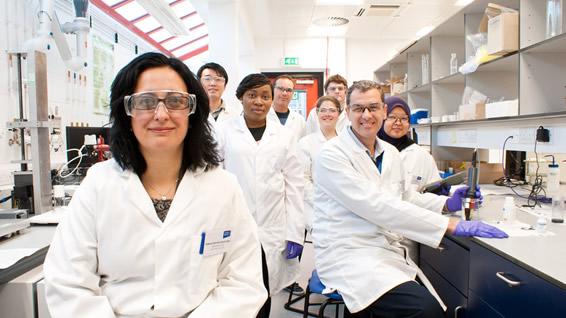Heriot-Watt University Researchers Win $3.3 Million Grant to 3D Print Smart Rocks to Capture Data on Underground Oil and CO2
 In order to secure our water, food and energy supplies while being able to maintain the safe extraction of oil and gas from underground oilfields, we need to have a better understanding of the layer of porous rocks in the subsurface. Specifically, the way that liquids and gases manage to travel through them, and how captured carbon dioxide (CO2) could be stored underground. Unfortunately the conditions of this subsurface material vary widely depending on the type of rock, the temperatures and the pressures that occur deep under the ground. Beyond the complexity of replicating specific environmental conditions, direct dynamic observations at the pore level are virtually impossible in a lab setting.
In order to secure our water, food and energy supplies while being able to maintain the safe extraction of oil and gas from underground oilfields, we need to have a better understanding of the layer of porous rocks in the subsurface. Specifically, the way that liquids and gases manage to travel through them, and how captured carbon dioxide (CO2) could be stored underground. Unfortunately the conditions of this subsurface material vary widely depending on the type of rock, the temperatures and the pressures that occur deep under the ground. Beyond the complexity of replicating specific environmental conditions, direct dynamic observations at the pore level are virtually impossible in a lab setting.
According to Professor Mercedes Maroto-Valer, holder of the Robert M Buchan Chair in Sustainable Energy Engineering at Heriot-Watt University , the problem is that the rocks are unable to tell us what’s happening to them. However Maroto-Valer and her team of researchers think that they have come up with a way to communicate with these subsurface rocks, the team wants to make their own rocks that are capable of communicating with us. Their research was promising enough that the team received a prestigious European Research Council Advanced Award so they can continue to pursue their research into developing 3D printed “smart rocks” capable of giving the team an inside look of what’s happening deep underground.
“While extensive work over the years has given us some idea about how liquids and gases move through porous rocks at a large scale, we haven’t been able to understand how the process works at the very small pore scale, and how that process can differ between different types of porous rocks. We are very excited about this award and the opportunity to bring interdisciplinary innovation, building upon Heriot-Watt’s world leading expertise in process and petroleum engineering and manufacturing. This will allow us to unlock engineering research challenges in reactive transport in porous networks, transforming technological and environmental engineering applications,” said Professor Maroto-Valer.
Maroto-Valer and her team will use a 3D printing process to produce their own porous rocks that will include multiple micro sensors embedded inside of them. The sensors will be able to transmit data directly to the research team, including detailed information about what actually happens to liquids and gases deep underground. The 3D printed smart rocks will be capable of providing information on the subsurface conditions and environment at a microscopic level, which is simply not possible to reproduce using traditional laboratory methods.
“By 3D printing our own core samples we can decide exactly what sort of rock we wish to study, and implanted micro-sensors will be able to tell us directly, in real-time, what is going on as gases and liquids pass through them. This fundamental knowledge at such a tiny scale will feed hugely into our understanding of such processes at the large scale and enable us to maximise the success of industries from oil extraction to water safety and the storage of captured CO2,” Maroto-Valer continued.
 The grant that Maroto-Valer and her team won was awarded by the “Excellent Science” pillar of Horizon 2020, the European Union’s research and innovation program focusing on enabling senior researchers to pursue their most promising ideas. There were more than 1,900 application submitted across all of the eligible panels and disciplines. The €3 million ($3.3 million) award was one of only sixteen grants that are intended to help researchers pursue frontier research in areas that could lead to potentially ground-breaking discoveries that will impact science and society. Discuss this research further over in the 3D Printed Smart Rocks forum at 3DPB.com.
The grant that Maroto-Valer and her team won was awarded by the “Excellent Science” pillar of Horizon 2020, the European Union’s research and innovation program focusing on enabling senior researchers to pursue their most promising ideas. There were more than 1,900 application submitted across all of the eligible panels and disciplines. The €3 million ($3.3 million) award was one of only sixteen grants that are intended to help researchers pursue frontier research in areas that could lead to potentially ground-breaking discoveries that will impact science and society. Discuss this research further over in the 3D Printed Smart Rocks forum at 3DPB.com.
Subscribe to Our Email Newsletter
Stay up-to-date on all the latest news from the 3D printing industry and receive information and offers from third party vendors.
You May Also Like
Gorilla Sports GE’s First 3D Printed Titanium Cast
How do you help a gorilla with a broken arm? Sounds like the start of a bad joke a zookeeper might tell, but it’s an actual dilemma recently faced by...
Nylon 3D Printed Parts Made More Functional with Coatings & Colors
Parts 3D printed from polyamide (PA, Nylon) 12 using powder bed fusion (PBF) are a mainstay in the additive manufacturing (AM) industry. While post-finishing processes have improved the porosity of...
$25M to Back Sintavia’s Largest Expansion of Metal 3D Printing Capacity Since 2019
Sintavia, the digital manufacturing company specializing in mission-critical parts for strategic sectors, announced a $25 million investment to increase its production capacity, the largest expansion to its operations since 2019....
Velo3D Initiates Public Offering in a Bid to Strengthen Financial Foundations and Drive Future Growth
Velo3D (NYSE: VLD) has been among a number of publicly traded 3D printing firms that have attempted to weather the current macroeconomic climate. After posting a challenging financial report for 2023,...
































